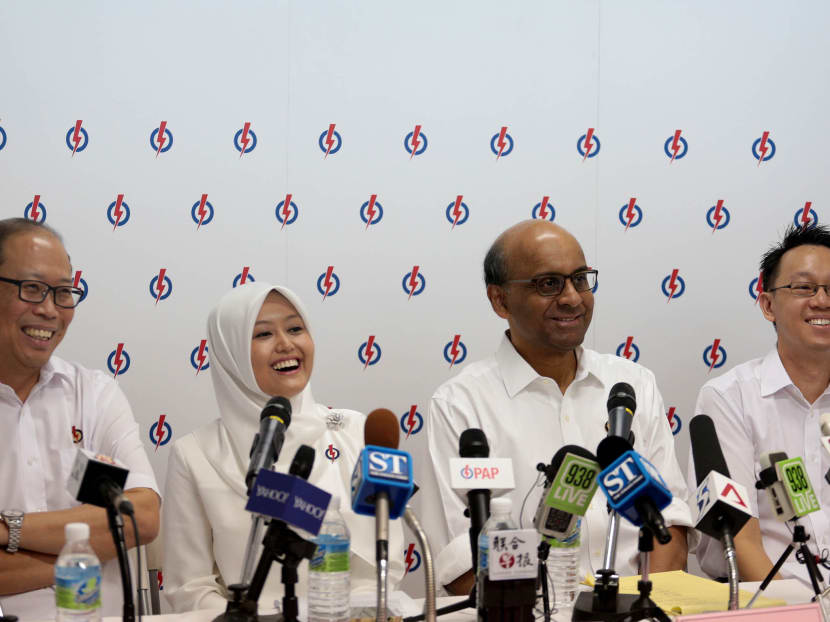PAP’s new faces more diverse, with more experience: Analysts
SINGAPORE — In comparison to their predecessors in the 2011 General Election (GE), the latest batch of People’s Action Party (PAP) new faces are more diverse in terms of their backgrounds, and this suggests that the ruling party has taken a deliberate attempt to draw candidates from sources apart from their usual hunting ground, political analysts said yesterday.

(From left to right) PAP candidate for Bukit Batok SMC David Ong, PAP candidates for Jurong GRC Mdm Rahayu Mahzam, Mr Tharman Shanmugaratnam, and Dr Tan Wu Meng react during a press conference on Aug 20, 2015. Photo: Jason Quah
SINGAPORE — In comparison to their predecessors in the 2011 General Election (GE), the latest batch of People’s Action Party (PAP) new faces are more diverse in terms of their backgrounds, and this suggests that the ruling party has taken a deliberate attempt to draw candidates from sources apart from their usual hunting ground, political analysts said yesterday.
The median age of the new candidates this time round is also higher, and the analysts felt that the PAP was mindful of not trotting out candidates who are too young, and could be deemed as too rough around the edges.
Over a period of slightly more than two weeks — between August 12 and last Friday — the PAP formally introduced its total slate of 89 candidates, including 21 who will be taking part in their maiden elections.
On Saturday, PAP secretary-general Lee Hsien Loong said at the launch of the party manifesto that several of the new candidates have the potential to become more than backbenchers, with some forming part of the fourth-generation leadership team, provided they are elected.
The median age of the new faces is 43 years old, compared to 39.5 in the previous GE. The youngest candidate is lawyer Rahayu Mahzam, 35, and the oldest is healthcare insurance firm chief executive Victor Lye, 53.
Among the debutants, 13 — or almost two-thirds — are from the private sector, and six are from the public sector. In comparison, only a third of the PAP’s slate of 24 first-time candidates for the 2011 GE were from the private sector, while 16 — including five from the labour movement — hailed from the public sector.
Noting that there are also two candidates from non-governmental organisations — Nee Soon GRC candidate Louis Ng and Tanjong Pagar GRC candidate Joan Pereira — Singapore Management University law don Eugene Tan said the PAP was seeking to respond to public expectations by having greater diversity.
“If most of its candidates are drawn from the same recruitment grounds in the public sector, there’s the real concern of group think and limited expertise,” he said.
In the 2011 GE, Ms Tin Pei Ling, at 27 years old, was the youngest new candidate. Now 31, she is still the youngest among all the PAP candidates contesting the coming polls. Ms Tin, who will be standing in the MacPherson single-seat ward, had previously acknowledged that parts of the electorate had questioned her maturity and ability when she was introduced as the PAP’s youngest candidate four years ago.
The analysts noted that the PAP would have taken note of the electorate’s reactions in 2011. Associate Professor Tan said: “First impressions matter tremendously. When they see a candidate who’s very young, there will be the stereotypes and concerns about what the candidate brings or doesn’t bring to the table.”
Institute of Policy Studies senior research fellow Gillian Koh added: “People can always take for granted that (the PAP’s) candidates will (have strong credentials) in terms of their personal standing. But over the past years, people also question whether they have shown that they are able to connect with the ground.”
Doing more ground work will require time, and this is reflected in the new candidates’ ages, she said.
National University of Singapore political scientist Hussin Mutalib said the PAP saw the need “to reduce the number of young candidates who were either scholars or bureaucrats but lacked grassroots exposure and personal skills in dealing with an electorate that is not only increasingly discerning, but has varied aspirations”.
Associate Professor Alan Chong of the S. Rajaratnam School of International Studies felt that, in general, the profiles of the new candidates fit those in the sandwich class, and would allow the PAP to “articulate its own views on how Singaporeans should cope with a global economy”. The new faces could also serve as role models that voters in that age range can relate to, he said.
Among the 21 new faces, only five were women — an identical number compared to the 2011 batch. The analysts noted that it remains a challenge to attract women to join politics.
Assoc Prof Chong felt that the harsh social media environment tend to put women candidates under a greater degree of scrutiny compared to their male counterparts.
Assoc Prof Tan pointed out society’s heavy expectations on women politicians, where they have to hold a job, run a household and be a politician at the same time, which is something not many are able to juggle. JOY FANG






